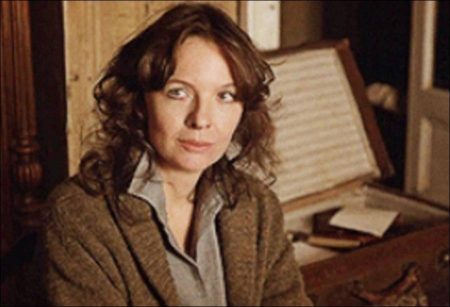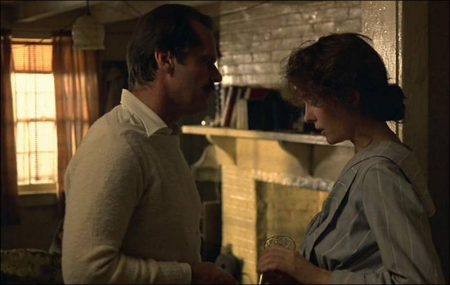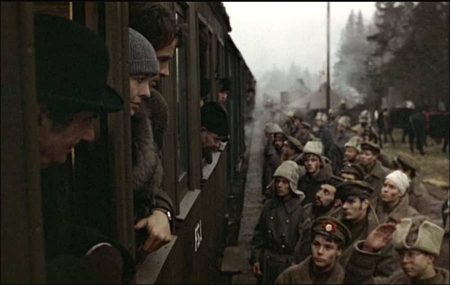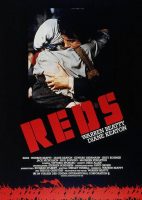Taglines: Not since Gone With The Wind has there been a great romantic epic like it!
Reds movie storyline. The joint lives of journalists and activists John Reed – referred to as Jack in familiar circumstances – and Louise Bryant from 1915 to 1920 are presented, the former who, at the time of the making of this movie, is the only American to be buried at the Kremlin in a place of honor.
In their life together, they are sometimes friends, sometimes lovers, sometimes spouses, but always idealists who hold steadfast to their beliefs. They initially meet in Portland, Oregon in 1915 when Jack returns to his hometown on a speaking engagement, he already a well known “liberal” journalist writing about how the working class is paying the price for the elitists calling the shots in the war, with Louise the repressed wife of dentist Paul Trullinger, she who has dabbled in journalism as a means of independence from her traditional life.
She is protective about her writing and how to get her point of view across, which often does not mesh even with those who may agree with that point of view. Jack and Louise attracted to each other sexually and emotionally, he asks her to return to New York with him both to be with him and to give her the freedom to write what she really wants. In New York, they associate with Jack’s friends – who include among others playwright Eugene O’Neill and writer/activist Emma Goldman – who largely dismiss Louise as a lightweight, just the latest of Jack’s girlfriends, and/or solely, in the minds of many of the men, a sexual being to be exploited. Despite their relationship/marriage largely at its end,

Jack is able to convince Louise to travel to Russia with him in 1917 to report on and be involved with the Bolshevik Revolution, which Jack feels could be the impetus for the end of the war, and if successful, a model for the American working class. It ends up being a game changer in their lives, for Jack seeing the success of the working class, and for Louise being caught up in the fervor of true idealism coming to fruition regardless of the specific issue.
The Revolution will have an impact on their lives in a different way as a possible cause of them never seeing each other again, as it causes Russia to be an isolated nation, the scourge of Communism, Jack who is largely seen as the face of it in the US, being something that most in the mainstream of American life would like to see eradicated, and Communism in Russia not being true to the academic definition of the term and perhaps not quite what Jack or his socialist associates in the US had envisioned.
Through it all, an issue in the background but one that plays an integral part of their story is Jack’s poor health, something that he does little to improve or care for in his goal of forwarding his leftist ideals. Interspersed with the dramatization of Jack and Louise’s life are current day interviews with real life players who knew Jack and/or Louise, or who knew of the issues with which they were dealing.
Reds is a 1981 American epic historical drama film co-written, produced, and directed by Warren Beatty. The picture centers on the life and career of John Reed, the journalist and writer who chronicled the Russian Revolution in his book Ten Days That Shook the World. Beatty stars in the lead role alongside Diane Keaton as Louise Bryant and Jack Nicholson as Eugene O’Neill.
The supporting cast includes Edward Herrmann, Jerzy Kosinski, Paul Sorvino, Maureen Stapleton, Gene Hackman, Ramon Bieri, Nicolas Coster, and M. Emmet Walsh. The film also features, as “witnesses,” interviews with the 98-year-old radical educator and peace activist Scott Nearing, author Dorothy Frooks, reporter and author George Seldes, civil liberties advocate Roger Baldwin, and the American writer Henry Miller, among others.
Beatty was awarded the Academy Award for Best Director and the film was nominated for Best Picture, but lost to Chariots of Fire. Beatty, Keaton, Nicholson, and Stapleton were nominated for Best Actor, Best Actress, Best Supporting Actor and Best Supporting Actress, respectively. Stapleton was the only one of the four to win.[a] Beatty became the third person to be nominated for Academy Awards in the categories Best Actor, Director, and, with co-writer Trevor Griffiths, Original Screenplay—losing again to Chariots of Fire—for a film nominated for Best Picture.
Filming
When principal photography began in August 1979 the original intention was for a 15- to 16-week shoot, but it ultimately took one year. Filming took place in five different countries and at various points the crew had to wait for snow to fall in Helsinki (and other parts of Finland), which stood in for the Soviet Union, and for rain to stop in Spain. A cottage in Kent was used to depict exteriors of the Reeds’ home in Croton-on-Hudson, which in reality was a small early American saltbox house.
The interior sets built at Twickenham Studios were also enlarged to evoke the “flavor” of the real home without reproducing it exactly. Other English locations included Frensham Ponds in Surrey, which stood in for Provincetown, the Smeaton Room of the Institution of Civil Engineers at One Great George Street for the Liberal Club meeting room in Portland, and the interior of Lancaster House for that of the Winter Palace in St. Petersburg.
Actress Maureen Stapleton was due to begin shooting her scenes in London in November 1979, but refused to take a plane because of a fear of flying. Because it was the wrong season for ocean liner travel, the production had to arrange for Stapleton to travel on a tramp steamer, which broke down in the North Atlantic and had to be towed to Amsterdam. This caused another unwelcome delay. Beatty would also not stop the camera between takes, letting it roll continuously, and insisted on a large number of takes. Paul Sorvino said he did as many as 70 takes for one scene; Stapleton had to do 80 takes of one scene, which caused her to say to Beatty, “Are you out of your fucking mind?”
Beatty and Keaton’s romantic relationship also began to deteriorate during filming. Peter Biskind wrote about the making of Reds, “Beatty’s relationship with Keaton barely survived the shoot. It is always a dicey proposition when an actress works with a star or director—both, in this case—with whom she has an offscreen relationship.
Keaton appeared in more scenes than any other actor save Beatty, and many of them were difficult ones, where she had to assay a wide range of feelings, from romantic passion to anger, and deliver several lengthy, complex, emotional speeches.” George Plimpton once observed, “Diane almost got broken. I thought [Beatty] was trying to break her into what Louise Bryant had been like with John Reed.” Executive producer Simon Relph adds, “It must have been a strain on their relationship because he was completely obsessive, relentless.”
Reds (1981)
Directed by: Warren Beatty
Starring: Warren Beatty, Diane Keaton, Edward Herrmann, Jerzy Kosinski, Jack Nicholson, Paul Sorvino, Maureen Stapleton, Nicolas Coster, Bessie Love, Eleanor D. Wilson, MacIntyre Dixon
Screenplay by: Warren Beatty, Trevor Griffiths
Production Design by: Richard Sylbert
Cinematography by: Vittorio Storaro
Film Editing by: Dede Allen, Craig McKay
Costume Design by: Shirley Russell
Art Direction by: Simon Holland
Music by: Stephen Sondheim, Dave Grusin
MPAA Rating: None.
Distributed by: Paramount Pictures
Release Date: December 4, 1981
Views: 171


